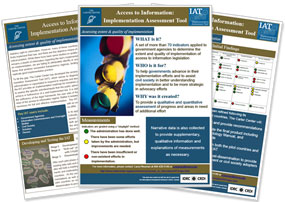The international trend of passing access to information legislation continues, with approximately 120 countries claiming a statutory right to information. However, many of these countries are failing to fully and effectively implement their laws, and there has been no objective means of analyzing and addressing this critical problem.
To address this critical gap, in 2009 the Rule of Law Program developed the access-to-information Implementation Assessment Tool (IAT), which serves the dual purpose of diagnosing the extent to which the public administration is capable of responding to requests for information and providing an implementation roadmap for government ministries and agencies so that they can better fulfill their duty to deliver information to citizens. The IAT is designed to assess a ministry’s or agency’s specific activities and inputs in furtherance of a well-implemented law. It is deliberately designed not to focus on the sufficiency of laws themselves, the requester side of the equation, or the overall effectiveness of the access-to-information regime. Rather, it is constructed to serve each public agency that undergoes assessment, helping it improve its capability to provide information.
The objectives of the Implementation Assessment Tool are to:
1. Establish a comprehensive set of access-to-information implementation benchmarks.
2. Identify the extent to which a ministry or agency has implemented its law.
3. Provide a roadmap for improvements, based on the tool’s findings.
4. Contribute to scholarship on implementation and to the understanding of implementation successes and challenges.
Ultimately, the IAT serves to encourage and support stakeholders (government, civil society, scholars, donors, etc.) to be more effective at advancing the right of access to information.
Over the past decade, the Rule of Law Program has worked with more than 75 subject experts and practitioners across the globe to develop, pilot, and refine the IAT. To date, it has been applied in more than 100 public agencies in 17 countries. The IAT is the first and most extensive diagnostic tool of its kind, offering findings and clear recommendations for improvement. The Center’s methodology is comprehensive and reliable, as it requires local, nongovernment researchers to conduct thorough desk reviews, site visits, and interviews with implementers, and validate those findings through blind peer reviewers and focal groups.
With the critical knowledge gained from IAT findings, governments can apply resources more wisely, and civil society organization can be more strategic in their advocacy efforts. Most importantly, the Implementation Assessment Tool’s recommendations have been used to assure that the right of access to information is meaningful and available for all persons.
Since 2009, the Center has worked to develop and fine-tune the Implementation Assessment Tool through desk research, consultant support, application in pilot countries, and peer reviews. The methodologies and indicators have undergone extensive validation, with a focus on the tool’s portability across countries and diverse legislative contexts. The tool's framing question would be, "To what extent is the agency capable of and prepared to provide information and respond to requests?"
Before finalizing the tool and rolling it out in new countries, the IAT was piloted in more than 10 countries to assure its efficacy and value. Through expert meetings and consultations, the IAT has evolved into a tool that can identify implementation progress and areas that need additional focus or improvement.
The IAT is designed as a matrix, with indicators related to baskets of activities (such as leadership, rules, systems, and resources) and government functions and responsibilities (receiving and responding to requests, proactive disclosure, and records management). The indicators include both quantitative and qualitative assessments of the comprehensiveness and quality of a ministry’s or agency’s implementation of access-to-information laws. Each indicator is scored on the "stoplight method," with a scale of green, yellow, red, and black and white (for those rare cases where the indicator does not apply), which helps easily demonstrate the extent and quality of implementation while dissuading people from indexing or ranking countries.
The Center engages local experts to serve as the researchers and blind peer reviewers. Data is drawn through desk research and interviews, and all findings go through a validation process via a blind peer review and focal group review. In addition to quantitative data, the researcher provides supplementary qualitative information and accompanying explanations for the measurements. Finally, representatives from the assessed ministries agencies are convened for a discussion of the findings. This event provides the administration an opportunity to better understand the IAT methodology and to review the findings prior to finalizing the report.
Beginning in 2009, the Rule of Law Program (then known as the Global Access to Information Project) developed the IAT methodology, including a set of indicators and a scoring system. Over the course of almost four years, the IAT was tested in three pilot phases in 11 countries (Mexico, South Africa, Bangladesh, Chile, Indonesia, Uganda, Scotland, Jordan, Georgia, Guatemala, and the United States) and 65 agencies. These pilot phases consisted of application and review of more than 8,000 indicators. Each pilot phase concluded with a review meeting of the researchers as well as a number of blind peer reviewers, government representatives, and access-to-information experts. The pilot concluded in April 2014, and the IAT was shared with the community of practice. Since finalizing the IAT methodology and indicators, the IAT has been implemented in six additional countries to assess agencies at the national and subnational level.
Please sign up below for important news about the work of The Carter Center and special event invitations.

Download PDFs: